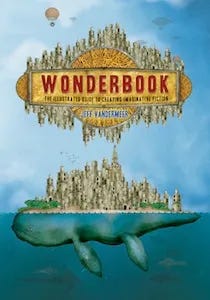This post is part of Art & Craft, my series that reviews books about writing books.
Wonderbook was written and curated by Jeff Vandermeer, a decorated author of weird literary fame, and features contributions from dozens of other notable names in contemporary SFF. Full of dreamlike illustrations, cryptic diagrams, and a cast of character guides, Wonderbook is, even at first glance, exactly what we should expect of a craft book by and for speculative fiction authors. Every page proves we are creative writers.
Why I chose this book
This was a second recommendation from Kris (who is two for two so far). Being familiar with the author’s work, I also knew that I could expect not only insights that would be relevant to SFF, but a perspective that recognizes the literary value of genre fiction. I wanted a craft book which explored worldbuilding without smothering narrative; capturing magic that adds too, instead of distracts from, our characters and their journeys.
Delivering, the book opens with Ward Shelley’s map of the history of science fiction. I’m squeaking this into my review because I looked at it for quite some time, maybe you should too.
The highlights
The collaborative effort
Glancing at the table of contents, this craft book seems similar to others at first. The chapters cover expected concepts such as the opening “hook”, characterization, narrative design, and revision. But Wonderbook is set apart by its representation of diverse authors and their ideas.
One could read the book fully, front to back, as I did. But (if I never returned my library copy) I could see myself skimming to revisit the insightful essays from contributors, such as Desirina Boskovich’s “The Challenges of Endings” or Kim Stanley Robinson’s “Thoughts on Exposition.”
This might be the best way to write a craft book, because who wants to write exactly like Jeff Vandermeer (or Le Guin or King or or or)? This approach lets readers broadly foster their imaginations, learning from writers of many styles and schools of thought, carrying us all further from derivative storytelling.
The opposite of “prescriptive”... the space to dream…
I searched the thesaurus and failed to find the perfect antonym. As we struggle to learn and teach a highly suggestive art, any “authority” on how to write risks becoming authoritative. No one is an expert on your art but you, but if you lack skill, as Le Guin wrote about in Steering the Craft, you’ll struggle to convey your vision.
Throughout Wonderbook, Vandermeer manages to present his own writing insights in a manner that consistently provokes the imagination instead of trying to steer it. I am impressed by how his approach to teaching remains aware of potential resistance to rules and recognizes myriads of exceptions. He uses modifiers like “typically” and “often,” to demonstrate techniques and methods that we should employ—or subvert only with intention. This approach leaves space for the readers of Wonderbook to develop their own style.
For example, in his chapter on characterization, he describes several categories and then acknowledges: “It also helps to understand that the boundaries between these approaches are porous, with variations and cross-pollination that make a mockery of categories.” [page 182] Overall in this chapter, he does not insist that characters must be complex, relatable, and dynamic, else we will lose our audience and never sell a single sentence. Of course, such characters can make for intriguing, compelling storytelling. But Vandermeer illustrates how “flat” characterization can be used to focus on events or aspects of the plot, as is common in folktales. He writes: “Although not true in every case, stories featuring flat characterization tend to behave like some ravenous beast feeding a monstrous and insatiable tale-producing stomach.” [page 183]
This example also demonstrates how his colorful prose and metaphors make Wonderbook enjoyable to read simply for its own sake. In some places, the rich language leads to deeper contemplation on concepts, such as in this example from the chapter on beginnings and endings: “A hook cannot be just a hook, either—it must be allure and alluring, and it must so be an anchor. You are inviting the reader to some sort of enjoyment or challenge or (perhaps) harrowing experience. Spending too much time on trying to hook the reader may well rob the opening of your book of its allure…” [page 79]
This last quote features rare instances of imperatives like “cannot” and “must,” but the effect still pushes you to hone the ideas you already have, not to abandon your work in pursuit of someone else’s framework or process. In fact, Vandermeer insists that: “Not understanding the unique conditions through which you tend to produce your best work tends to make everything else much harder.” [page 75]
I’ll close this section with his strong opinions on our favorite f-word, formula, shared in his initial chapter, which is dedicated to fostering the imagination:
“Inherent in this idea of “play” being immature and frivolous is the idea that, just like business processes, all creative processes should be efficient, timely, linear, organized, and easily summarized. If it’s not clearly a means to an end, it must be a waste of time. In the worst creative writing books, this method is expressed in seven-point plot outlines and other easy shortcuts rather than as exercises to help encourage the organic development of your approach. This kind of codification sometimes reflects fear of the uncertainty of the imagination and the need to have a set of rules in place through which to understand the universe.” [page 8]
Sounds like he’s read some of the books we have!
The cringe
Ultimately, I can find very little fault with Wonderbook. The exercises in the appendix are a little more surreal and specific than I would prefer, and occasionally the layouts and diagrams are not entirely comprehensible. But that is all part of the fun.
The question I’m left with is this: With its fantastical art and phantasmagoric trappings, would authors who are not contributing to the SFF genre know to pick up the Wonderbook?
Maybe not, since genre fiction writers are still the stepchildren of the literary world (as demonstrated by limited genre representation in NYT’s recent 100 Best Books of the 21st-Century list).
Though we have seen how SFF and other genre fiction can be cerebral, and explore the human condition, and influence culture, and meet any other editorial qualification which might earn the moniker “literary.” Kazuo Ishiguro, Emily St. John Mandel, Octavia Butler, Vandermeer himself, and many others have long proven this. In a section titled “The Fantastical and the Imagination,” Vandermeer reminds us that snobbery is nonsense.
In considering the work of “fantasy” and “science fiction”—modes of fiction still perceived as valuing concepts and settings over characters—this sense of imagination being “frivolous” is allied to society’s ideas of what is “serious”: versus what is “entertainment.” Fantastical writers like Ursula K. Le Guin, Jorge Luis Borges, and Italo Calvino might be inextricably intertwining play with their explorations of complex intellectual ideas, but this aspect is often ignored in reviews, perhaps because it is considered irrelevant to the “point” of good fiction. Instead of being essential, core, inseparable from. [page 9]
So go forth and go crazy.
And don’t forget to play!
I love this idea of play as essential to storytelling. I am fortunate. I get to play a lot these days, sitting on the floor with my daughter in a catastrophe of books, easter eggs, trains, dry pasta, and other things she loves. Adults should play more often. I don’t mean entertainment, which I would characterize with consumption and distraction. Play is more present, more exploratory, and possibly productive.
Writing can be play. In a certain mindset, it can be rejuvenating, in the true sense of the word “recreation.” As that chapter on imagination theorizes: “If you reward your imagination by writing down your ideas and exploring them, even the slightest fragment, your imagination will reward you with a more or less continuous stream of ideas. If you turn off or blunt the enthusiasm of your subconscious for engaging in creative play, the stream can dry up.” [page 18]
This explains why I get cranky if I don’t have a solid writing session every other day or so.
With a story constantly in my mind, the subject of my daydreams, it becomes the “resting state” of my brain, where it naturally begins to grow. For me, the magic lies in writing often enough to truly explore an idea and even finish a story—without guilting myself into a toxic “hustle” mindset.*
Star-ratings
How useful is this craft book?
3 out of 3 stars - ★★★
How humble is this craft book?
3 out of 3 stars - ★★★
How concise is this craft book?
3 out of 3 stars - ★★★
*If you want to read more on how to beat yourself toward writing more, I direct you to Steven Pressfield’s War of Art. I have, however, decided not to include that book in this review series because the perfect review of it already exists.






I have Booklife from Vandameer, (Jacob may as well) but this sounds liek its worth grabbing. Great breakdown! Thanks!
I have Wonderbook on Kindle and have been enjoying it greatly. This review is inspiring me to finally pick it up in print too, though!